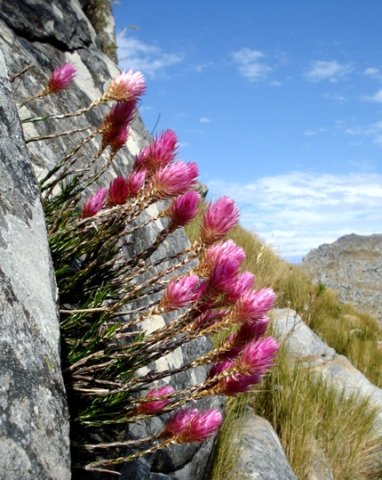Edmondia pinifolia where it may escape fire

Author: Ivan Lätti
Photographer: Judd Kirkel Welwitch
Edmondia pinifolia is a resprouter after fynbos fires; the multiple stems suggesting a woody underground base. A plant elevated in a rock crevice like the one in picture may even be spared incineration. That is if the plants below don’t burn too fiercely like when they are still short, or the momentary whim of the wind is favourable.
Some citizens hurt in sympathy with the destroyed plants and animals living through these sporadic conflagrations. While the destruction and loss are often disturbing, fynbos is dependent on the occasional fire. It serves to destroy woody thicket and deposits nutrients into the often infertile soil. This allows the low-growing species to have their turn for flourishing during one or a few flowering seasons in the sun.
Fynbos has so many species, in many places too many for all of them to peak simultaneously. The burning cycle serves as a time-share mechanism among the species, keeping them all alive and participating in the mix, taking turns. Fire also triggers the germination of the seed of certain species. Human activities often bring about fires too frequently, causing erosion, species destruction and other untoward phenomena.
Much has been written about the ideal fire frequency without overall consensus yet. The life cycles of different species suggest different answers. People often focus on a few species of their choice. If people cause no fires at all, nature will continue following its own irregular pattern, for now working just fine for fynbos. Humans can improve their own culture(s), never nature as a whole. Given today's fragmentation of residual fynbos patches in many parts, our manipulation rarely works well.
Once nature is interfered with, it responds. The outcomes are often irrelevant to human interests, although sometimes accidentally beneficial to our interests or sentiments. Beneficial is, of course, a human perspective. Nature remains what it is, continuing on its open-ended, bigger scale. Managers talk about "the art of the possible". Nature lives it, outliving every species through ongoing evolution of all surviving species of the moment in the conditions that prevail.
Cause and effect patterns in nature, one big and interactive system, are multidimensional, too complex for people to fathom fully. The human mission of conservation is always an incomplete affair, solving and causing problems continually and concurrently as our values and purposes conflict in so many ways. The range of positive actions increases through good efforts, while perfection is not for us. The various inspired causes, custodian or selfish, all based on subsets of incomplete knowledge, inevitably conflict among each other. Meanwhile nature does its own thing while humanity serves and blunders in the sometimes downward spiral nature endures in our time.
The three Edmondia species, all endemic to sandstone slopes of the Western Cape fynbos, are still surviving human adoration and destruction fairly well early in the twenty first century (Manning, 2007; Bond and Goldblatt, 1984; http://redlist.sanbi.org).

